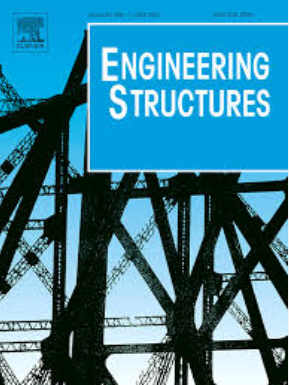Mitigating damages to infill walls under combined in-plane and out-of-plane loadings using a spider web-inspired strengthening strategy: Numerical analyses
IF 5.6
1区 工程技术
Q1 ENGINEERING, CIVIL
引用次数: 0
Abstract
Unreinforced masonry walls (IMW) are commonly used as infills to envelop and partition reinforced concrete (RC) frame buildings. These IMWs are non-loadbearing, however they contribute to the in-plane (IP) load resisting mechanism of the RC frames and are prone to out-of-plane (OOP) failure during lateral actions, such as earthquakes, impacts, tsunamis, and high winds. The OOP failure of IMWs is influenced by prior IP damage, and therefore the characteristics of bi-directional interaction (IP and OOP) should be accounted to assess the appropriate OOP capacity of IMWs in RC frames. However, limited studies have been reported on the bi-directional failure characteristics of IMWs, especially mitigation of this failure and increasing the OOP capacity of the walls without increasing the stiffness in the IP direction. In this research study, finite element (FE) based numerical models of IMWs under bi-directional loadings has been developed and validated using existing experimental data. Numerical and experimental results show good agreement of failure modes and both IP and OOP load-displacement characteristics. To mitigate their failure, a nature inspired spider-web grid (as a surface rending strengthening system) was applied to the IMWs and their IP and OOP responses were evaluated numerically. Using spider-web-inspired reinforcement on the rear face of the IMWs yielded a 31 % increase in their out-of-plane capacity with an increase in out-of-plane displacement by 2.7 times compared to the unreinforced IMW configuration. Findings of this paper will help to improve the designs of IMWs vulnerable to combined IP and OOP loadings.
利用受蜘蛛网启发的加固策略减轻填充墙在平面内和平面外联合荷载作用下的损坏:数值分析
无筋砌体墙(IMW)通常用作钢筋混凝土(RC)框架建筑的围护和隔墙。这些内砌墙是非承重的,但它们对 RC 框架的平面内(IP)荷载抵抗机制有贡献,并且在地震、撞击、海啸和大风等横向作用时容易发生平面外(OOP)破坏。IMW 的 OOP 破坏受先前 IP 破坏的影响,因此应考虑双向相互作用(IP 和 OOP)的特点,以评估 RC 框架中 IMW 的适当 OOP 承载能力。然而,有关 IMW 双向破坏特性的研究报告有限,尤其是在不增加 IP 方向刚度的情况下,如何缓解这种破坏并提高墙体的 OOP 承载力。在这项研究中,开发了基于有限元(FE)的双向荷载下的 IMW 数值模型,并利用现有的实验数据进行了验证。数值和实验结果表明,失效模式以及 IP 和 OOP 载荷-位移特性均十分吻合。为减轻其失效,在 IMW 上应用了受自然启发的蛛网网格(作为表面加固系统),并对其 IP 和 OOP 响应进行了数值评估。与未加固的 IMW 结构相比,在 IMW 的后端面使用受蜘蛛网启发的加固结构可使其平面外承载力提高 31%,平面外位移增加 2.7 倍。本文的研究结果将有助于改进易受 IP 和 OOP 联合荷载影响的 IMW 的设计。
本文章由计算机程序翻译,如有差异,请以英文原文为准。
求助全文
约1分钟内获得全文
求助全文
来源期刊

Engineering Structures
工程技术-工程:土木
CiteScore
10.20
自引率
14.50%
发文量
1385
审稿时长
67 days
期刊介绍:
Engineering Structures provides a forum for a broad blend of scientific and technical papers to reflect the evolving needs of the structural engineering and structural mechanics communities. Particularly welcome are contributions dealing with applications of structural engineering and mechanics principles in all areas of technology. The journal aspires to a broad and integrated coverage of the effects of dynamic loadings and of the modelling techniques whereby the structural response to these loadings may be computed.
The scope of Engineering Structures encompasses, but is not restricted to, the following areas: infrastructure engineering; earthquake engineering; structure-fluid-soil interaction; wind engineering; fire engineering; blast engineering; structural reliability/stability; life assessment/integrity; structural health monitoring; multi-hazard engineering; structural dynamics; optimization; expert systems; experimental modelling; performance-based design; multiscale analysis; value engineering.
Topics of interest include: tall buildings; innovative structures; environmentally responsive structures; bridges; stadiums; commercial and public buildings; transmission towers; television and telecommunication masts; foldable structures; cooling towers; plates and shells; suspension structures; protective structures; smart structures; nuclear reactors; dams; pressure vessels; pipelines; tunnels.
Engineering Structures also publishes review articles, short communications and discussions, book reviews, and a diary on international events related to any aspect of structural engineering.
 求助内容:
求助内容: 应助结果提醒方式:
应助结果提醒方式:


